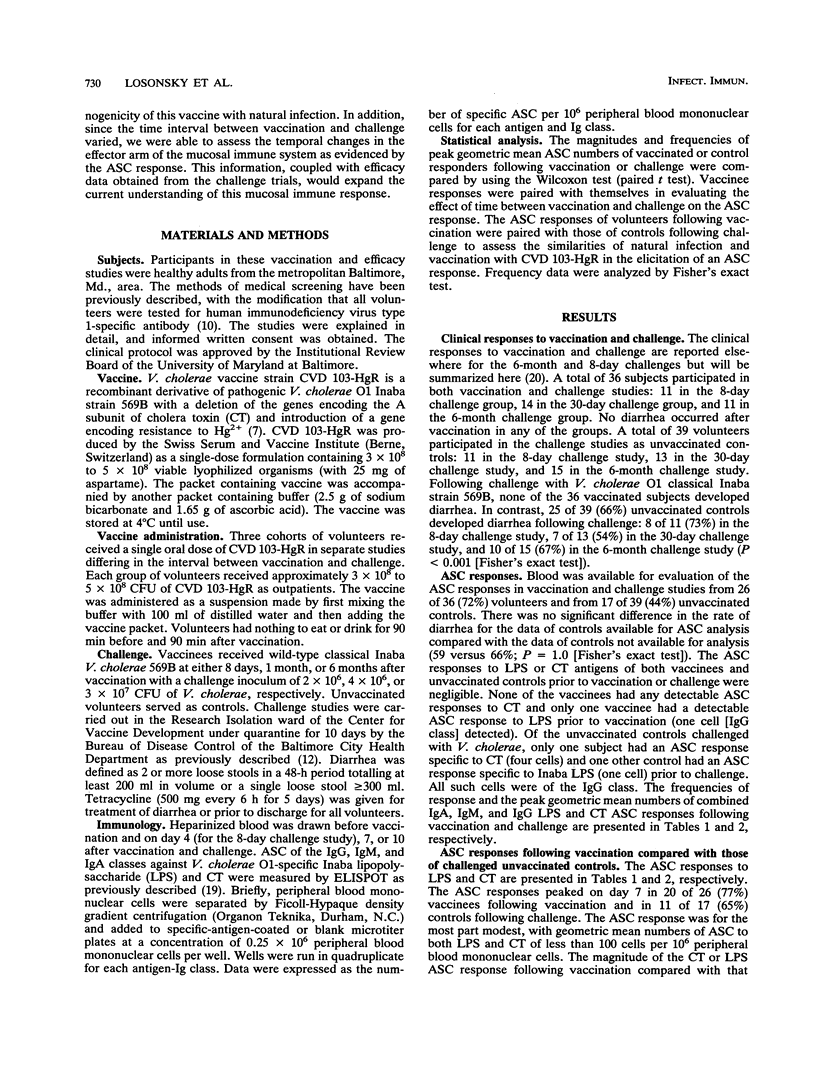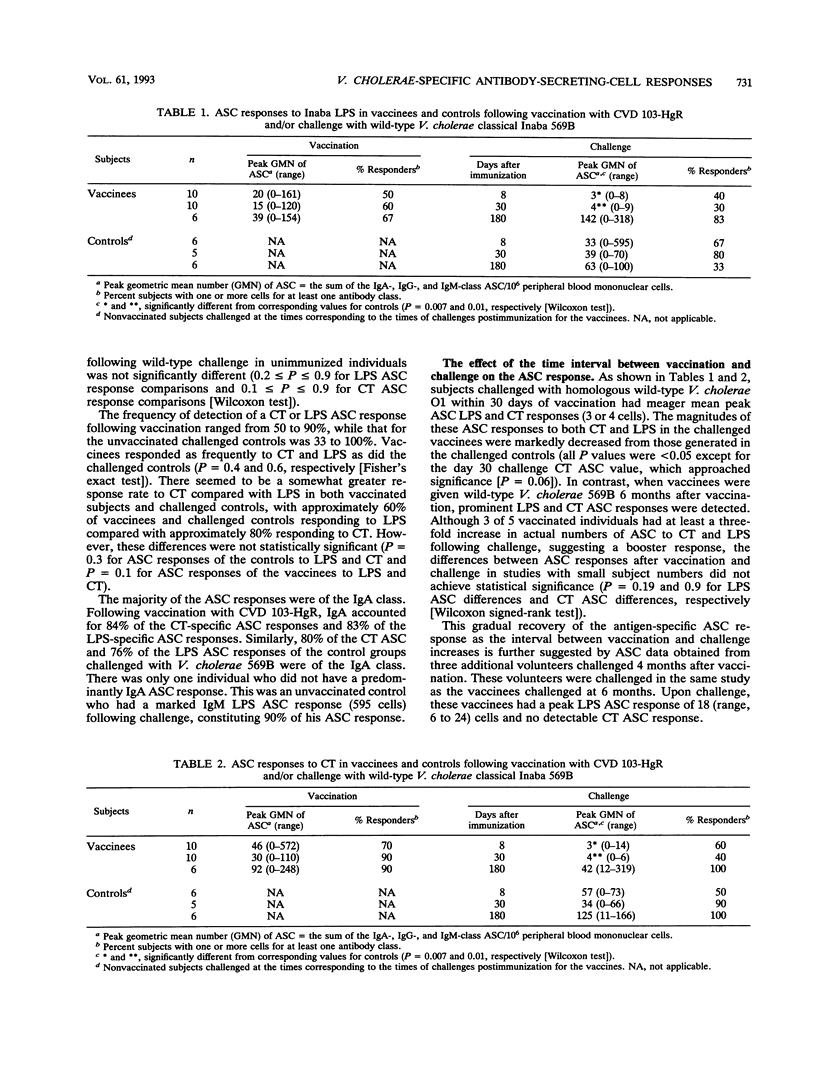Abstract
Peripheral blood immunoglobulin A antibody-secreting-cell (ASC) responses are thought to reflect the mucosal immune response to locally presented antigens. We evaluated the ASC response to cholera toxin (CT) and Inaba lipopolysaccharide (LPS) in 26 North American volunteers following immunization with a single oral dose of live attenuated Vibrio cholerae O1 vaccine strain CVD 103-HgR and again upon homologous wild-type challenge with V. cholerae classical Inaba 569B. Challenge occurred at either 7, 30, or 180 days after vaccination. The CT and LPS ASC responses of volunteers following vaccination (83 and 55%, respectively) were similar in magnitude and frequency to those of unvaccinated controls following wild-type challenge (80 and 60%, respectively [0.1 < or = P < or = 0.9]). The responses were primarily immunoglobulin A. Vaccinated volunteers challenged within 30 days of vaccination had reduced or nondetectable CT and LPS ASC responses. Challenge at 6 months resulted in a heightened ASC response to LPS, confirming the existence of mucosal memory. ASC responses to CT upon challenge at 6 months were detectable but not different from that seen following primary immunization, suggesting that secondary ASC responses to different antigens from a single vaccine operate independently. In spite of these variable ASC responses, the vaccine efficacy was 100% following challenge for all vaccinees. V. cholerae-specific ASC responses following antigenic reexposure gave information on the presence of mucosal B memory cells but did not correlate with protective immunity. As such, these ASC assays will have limited usefulness for evaluating vaccine responders in vaccine field trials in cholera-endemic areas where prior V. cholerae O1 exposure is unknown.
Full text
PDF




Selected References
These references are in PubMed. This may not be the complete list of references from this article.
- Czerkinsky C., Prince S. J., Michalek S. M., Jackson S., Russell M. W., Moldoveanu Z., McGhee J. R., Mestecky J. IgA antibody-producing cells in peripheral blood after antigen ingestion: evidence for a common mucosal immune system in humans. Proc Natl Acad Sci U S A. 1987 Apr;84(8):2449–2453. doi: 10.1073/pnas.84.8.2449. [DOI] [PMC free article] [PubMed] [Google Scholar]
- Herrington D. A., Hall R. H., Losonsky G., Mekalanos J. J., Taylor R. K., Levine M. M. Toxin, toxin-coregulated pili, and the toxR regulon are essential for Vibrio cholerae pathogenesis in humans. J Exp Med. 1988 Oct 1;168(4):1487–1492. doi: 10.1084/jem.168.4.1487. [DOI] [PMC free article] [PubMed] [Google Scholar]
- Kantele A., Arvilommi H., Jokinen I. Specific immunoglobulin-secreting human blood cells after peroral vaccination against Salmonella typhi. J Infect Dis. 1986 Jun;153(6):1126–1131. doi: 10.1093/infdis/153.6.1126. [DOI] [PubMed] [Google Scholar]
- Kantele A., Kantele J. M., Arvilommi H., Mäkelä P. H. Active immunity is seen as a reduction in the cell response to oral live vaccine. Vaccine. 1991 Jun;9(6):428–431. doi: 10.1016/0264-410x(91)90130-x. [DOI] [PubMed] [Google Scholar]
- Kantele A., Mäkelä P. H. Different profiles of the human immune response to primary and secondary immunization with an oral Salmonella typhi Ty21a vaccine. Vaccine. 1991 Jun;9(6):423–427. doi: 10.1016/0264-410x(91)90129-t. [DOI] [PubMed] [Google Scholar]
- Kaper J. B., Lockman H., Baldini M. M., Levine M. M. Recombinant nontoxinogenic Vibrio cholerae strains as attenuated cholera vaccine candidates. Nature. 1984 Apr 12;308(5960):655–658. doi: 10.1038/308655a0. [DOI] [PubMed] [Google Scholar]
- Kehrl J. H., Fauci A. S. Activation of human B lymphocytes after immunization with pneumococcal polysaccharides. J Clin Invest. 1983 Apr;71(4):1032–1040. doi: 10.1172/JCI110830. [DOI] [PMC free article] [PubMed] [Google Scholar]
- Levine M. M., Black R. E., Clements M. L., Cisneros L., Nalin D. R., Young C. R. Duration of infection-derived immunity to cholera. J Infect Dis. 1981 Jun;143(6):818–820. doi: 10.1093/infdis/143.6.818. [DOI] [PubMed] [Google Scholar]
- Levine M. M., Black R. E., Clements M. L., Lanata C., Sears S., Honda T., Young C. R., Finkelstein R. A. Evaluation in humans of attenuated Vibrio cholerae El Tor Ogawa strain Texas Star-SR as a live oral vaccine. Infect Immun. 1984 Feb;43(2):515–522. doi: 10.1128/iai.43.2.515-522.1984. [DOI] [PMC free article] [PubMed] [Google Scholar]
- Levine M. M., Kaper J. B., Herrington D., Losonsky G., Morris J. G., Clements M. L., Black R. E., Tall B., Hall R. Volunteer studies of deletion mutants of Vibrio cholerae O1 prepared by recombinant techniques. Infect Immun. 1988 Jan;56(1):161–167. doi: 10.1128/iai.56.1.161-167.1988. [DOI] [PMC free article] [PubMed] [Google Scholar]
- Levine M. M., Nalin D. R., Craig J. P., Hoover D., Bergquist E. J., Waterman D., Holley H. P., Hornick R. B., Pierce N. P., Libonati J. P. Immunity of cholera in man: relative role of antibacterial versus antitoxic immunity. Trans R Soc Trop Med Hyg. 1979;73(1):3–9. doi: 10.1016/0035-9203(79)90119-6. [DOI] [PubMed] [Google Scholar]
- Lycke N., Lindholm L., Holmgren J. Cholera antibody production in vitro by peripheral blood lymphocytes following oral immunization of humans and mice. Clin Exp Immunol. 1985 Oct;62(1):39–47. [PMC free article] [PubMed] [Google Scholar]
- Parsot C., Taxman E., Mekalanos J. J. ToxR regulates the production of lipoproteins and the expression of serum resistance in Vibrio cholerae. Proc Natl Acad Sci U S A. 1991 Mar 1;88(5):1641–1645. doi: 10.1073/pnas.88.5.1641. [DOI] [PMC free article] [PubMed] [Google Scholar]
- Pierce N. F., Cray W. C., Jr Determinants of the localization, magnitude, and duration of a specific mucosal IgA plasma cell response in enterically immunized rats. J Immunol. 1982 Mar;128(3):1311–1315. [PubMed] [Google Scholar]
- Richardson K., Kaper J. B., Levine M. M. Human immune response to Vibrio cholerae O1 whole cells and isolated outer membrane antigens. Infect Immun. 1989 Feb;57(2):495–501. doi: 10.1128/iai.57.2.495-501.1989. [DOI] [PMC free article] [PubMed] [Google Scholar]
- Svennerholm A. M., Jertborn M., Gothefors L., Karim A. M., Sack D. A., Holmgren J. Mucosal antitoxic and antibacterial immunity after cholera disease and after immunization with a combined B subunit-whole cell vaccine. J Infect Dis. 1984 Jun;149(6):884–893. doi: 10.1093/infdis/149.6.884. [DOI] [PubMed] [Google Scholar]
- Tacket C. O., Hone D. M., Curtiss R., 3rd, Kelly S. M., Losonsky G., Guers L., Harris A. M., Edelman R., Levine M. M. Comparison of the safety and immunogenicity of delta aroC delta aroD and delta cya delta crp Salmonella typhi strains in adult volunteers. Infect Immun. 1992 Feb;60(2):536–541. doi: 10.1128/iai.60.2.536-541.1992. [DOI] [PMC free article] [PubMed] [Google Scholar]
- Tacket C. O., Losonsky G., Nataro J. P., Cryz S. J., Edelman R., Kaper J. B., Levine M. M. Onset and duration of protective immunity in challenged volunteers after vaccination with live oral cholera vaccine CVD 103-HgR. J Infect Dis. 1992 Oct;166(4):837–841. doi: 10.1093/infdis/166.4.837. [DOI] [PubMed] [Google Scholar]
- Van de Verg L., Herrington D. A., Murphy J. R., Wasserman S. S., Formal S. B., Levine M. M. Specific immunoglobulin A-secreting cells in peripheral blood of humans following oral immunization with a bivalent Salmonella typhi-Shigella sonnei vaccine or infection by pathogenic S. sonnei. Infect Immun. 1990 Jun;58(6):2002–2004. doi: 10.1128/iai.58.6.2002-2004.1990. [DOI] [PMC free article] [PubMed] [Google Scholar]


